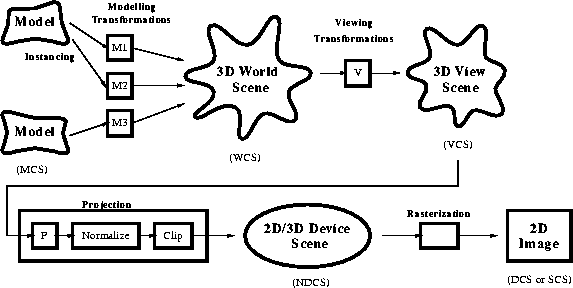
Last Updated September 12, 2016
The study of 3 Dimensional Computer Graphics involves examining techniques and tools which enable a computer to generate images. These images can range from simple text characters, like the ones you are just reading, to realistic photographic quality pictures.
Computer Graphics are used in a wide variety of different fields:
The bulk of this course is be concerned with transforming a description of a real world scene into a form that can be viewed on a computer display device such as a monitor. Always at the back of our mind will be the efficiency of our techniques as graphics processing is a notoriously expensive in terms of computing resources.
A general process for viewing 3-dimensional scenes has been developed, this process is known as the rendering pipeline.

The first part of the rendering pipeline is to describe our scene in a way which is amenable to efficient processing. This typically involves decomposing the scene into its simple components, describing those components in terms of mathematical equations and, ultimately polygon meshes. These individual meshes are recombined using various transformations to build a mathematical representation of the entire scene. At this stage the model is said to be in world coordinates.
Next, we build a virtual camera, position and orient it in space so that it 'sees' the view of the scene which we want to display. This camera defines a new coordinate system called the viewing coordinates. The world coordinates of the model need to be transformed to viewing coordinate.
At this point the model is still in 3-dimensions. The next step is to project the model on to a 2 dimensional viewplane, just as a camera projects the real world on to a flat piece of film. Also, areas of the scene which are outside the intended viewing rectangle need to be clipped away.
Now the scene is a 2-dimensional model ready to be converted into a set of pixels for display. Here faces which are turned away from the eye need to be removed. Faces which are hidden also need to be correctly processed. A lot of processing happens at this point as the mathematical description of the scene is turned into a set of pixels. This is (usually) the final stage, the scene can now be displayed on the computer screen, printer, projector etc.
© Ken Power 1996-2016